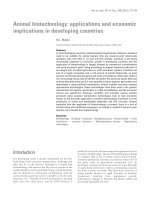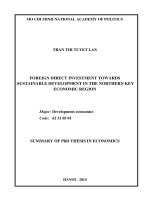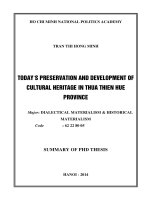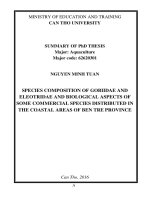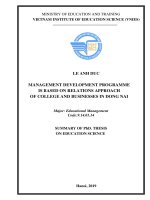Summary of PhD thesis: Public expenditure, governance and economic growth in developing countries
Bạn đang xem bản rút gọn của tài liệu. Xem và tải ngay bản đầy đủ của tài liệu tại đây (722.2 KB, 29 trang )
MINISTRY OF EDUCATION AND TRAINING
UNIVERSITY OF ECONOMICS HO CHI MINH CITY
-------------TRAN TRUNG KIEN
PUBLIC EXPENDITURE, GOVERNANCE AND ECONOMIC
GROWTH IN DEVELOPING COUNTRIES
Major: Finance and Banking
Code: 62460201
SUMMARY OF PHD THESIS
Academic Advisors
Prof. Dr. SU DINH THANH
TP. Hồ Chí Minh – năm 2018
CHAPTER 1: INTRODUCTION
1.1 The reason for study
The reason for choosing the research topic comes from factual
context and research gap.
The practical context shows that the impact of public expenditure
on economic growth be extremely essential in developing countries.
Although the situation is different, the common denominator in
developing countries is that along with high economic growth, these
countries are facing with increasing public expenditure problems,
large budget deficits and poor public governance.
Literature review shows that the impact of public expenditure on
economic growth in developing countries remains controversial.
Interpretation of the results of the combined test for the economic
impact of public expenditure, some studies point to factors affecting
the impact of public expenditure on economic growth, including:
expenditure structure, how public expenditure is financed, growth
rates, threshold values and the quality of public governance (Afonso
& Jalles, 2016; Gemmell et al., 2012; Halkos & Paizanos, 2016).
Previous papers consider each of these factors individually, so it does
not provide comprehensive empirical evidence on the impact of
public expenditure on economic growth (Halkos & Paizanos, 2016).
Governance is a multidimensional concept (Acemoglu, 2008,
Quibria, 2014).
Accordingly, the subject of the thesis is "Public Expenditure,
Governance and Economic Growth in Developing Countries"
The thesis examines the relationship between public expenditure and
economic growth in budget constraints as well as the role of public
governance in developing countries for the period between 1998 and
1
2016.Theo đó, đề tài mà luận án hướng đến là “Chi tiêu công, quản
trị công và tăng trưởng kinh tế tại các quốc gia đang phát triển”.
1.2 The objectives and research questions
The thesis addresses two main research objectives: (1) Evaluate the
impacts of public expenditure to economic growth in the budget
constraint and (2) evaluate the role of governance in the relationship
between public expenditure and economic growth in developing
countries. The thesis aims to answer the specific research questions
as follows:
+ What is the role of budget constraints in the relationship between
public expenditure and economic growth in developing countries?
+ Is there a difference in the economic efficiency of public
expenditure components between pre- and post-crisis period?
For the second research objective, the research questions should be
addressed as follows:
+ How does public governance work to adjust the impact of public
expenditure components on economic growth in developing
countries?
+ What is the role of political institutions in adjusting the impact of
public expenditure components on economic growth in developing
countries?
1.3 Research method
Analysis and discussion are mainly based on GMM Approach. In
addition, the thesis finds threshold values by Hansen's method
(1999).
2
1.4 Scope of the Study
The scope of this study is the relationship between public
expenditure, governance and economic growth, along with other
variables such as investment, human capital and public debt in
developing countries for the period 1998-2016.
1.5 Result and new contributions
For the first objective, the analysis which examines the role of
budget constraints, public expenditure components, non-linear effect
and economic crisis in the relationship between public expenditure
and economic growth is an interesting point of the thesis.
For the second goal, the difference of the thesis is analyzing
governance in many dimensions in the relationship between public
expenditure and economic growth.
1.6. Research strategy
The thesis consists of the following main steps: (1) Outline the
theories; (2) Identify objectives and research questions (3) Establish
empirical models and data collection; (4) Result and analyze; (5)
Conclusions and policy implications.
1.7. Thesis’s Structure
The thesis consists of 5 main chapters. Apart from chapter I, the
thesis contents are structured as follows: Chapter II: Literature
review; Chapter III: evaluating the impact of public expenditure
structure on economic growth in budget constraints; Chapter IV:
Evaluating the role of government in the relationship between public
expenditure and economic growth ;Chapter V: Conclusions and
Policy Implications.
3
CHAPTER 2: LITERATURE REVIEW
2.1 Related concepts
2.1.1 Economic growth
Economic growth is an increase in the productivity of a country over
time.
2.1.2 Public expenditure
2.1.2.1 The concept
Public expenditure
is understood as the distribution and use of
public financial resources of the government. Public expenditure is
also considered as an important financial tool of the state, helping the
state intervene in economic activities to stabilize the macroeconomic
environment (Su Dinh Thanh & Bui Thi Mai Hoai, 2009).
2.1.2.1 Productive and unproductive expenditure
In endogenous growth models, according to Kneller & ctg (1999),
the classification of productive expenditure or unproductive
expenditure is based on whether the public expenditure is included in
the production function or not.
In empirical research, it is difficult to distinguish between productive
expenditure and unproductive expenditure (Devarajan et al., 1996;
Gemmell et al., Knoss & ctg, 1999). The thesis classifies productive
expenditure and unproductive expenditure components based on the
study by Bayraktar & Moreno- Dodson (2015). In particular, the
components of expenditure on education, health, communication and
transport.
2.1.3 Governance
Governance is a multi-dimensional concept, consisting of three main
aspects: political institutions; government effectiveness; and legal
framework (Acemoglu, 2008; Quibria, 2014).
4
2.2 The relationship between public expenditure and economic
growth
2.2.1 Relationship between public expenditure and economic
growth
The relationship between public expenditure and growth is
interpreted by various theories.
2.2.1.1 Wagner’s Law
According
to
Wagner's
Law,
economic
growth,
due
to
industrialization, will lead to an increase in public expenditure.
2.2.1.2 Keynesian Growth Model
According to this theory, public expenditure is considered as a
derivative of economic growth.
2.2.1.3 Neo-classical growth theory
In contrast, neoclassical theory makes the hypothesis of the
"overriding" effect of public expenditure on private investment.
2.2.1.4 Ricardian equivalence
Ricardian equivalence states that fiscal policy does not have the
effect of "boosting" and "overrunning" private capital (Barro, 1974;
Zagler & Dürnecker, 2003).
2.2.1.5 Endogenous growth theory
Endogenous growth models are expanded in different trends. Some
scholars have expanded, examining the role of government spending
in endogenous growth models, which are typical of Barro (1990) and
Devarajan & ctg (1996).
2.2.1.6 Armey curve
The Armey curve shows that there is a nonlinear relationship
between public expenditure and economic growth.
5
2.2.2 Public expenditure composition and economic growth
Devarajan et al. (1996) based on Barro's model (1990) to model the
study, examining the various components of public expenditure on
economic growth.
Thus, the relationship between public expenditure and growth is
interpreted by various theoretical foundations and developed in
different trends. Concluding from the above discussion, the thesis
builds on the relationship between public expenditure and economic
growth as the impact of public expenditure on economic growth
depends on the structure of public expenditure and the way in which
these expenditures are funded and the impact is different in each
case.
2.2.3 The relationship between public expenditure and economic
growth in budget constraint
Based on previous studies, the thesis extends Barro (1990) in order
to analyze the role of budget constraints and public expenditure
components in the relationship between public expenditure and
economic growth::
𝑘𝑡+1 −𝑘𝑡
𝑘𝑡
= −1 +
1
𝛼
(1 − 𝛼)𝜏]𝐴 𝑥
𝛽
1+𝛽
1−𝛼
𝛼
(1 − 𝜏)(1 − 𝛼)𝐴𝑧𝑡1−𝛼 𝑘𝑡𝛼−1 − [𝑔 + 𝑥 −
1
− (1 + 𝛼𝐴𝛼 𝑥
1−𝛼
𝛼
𝑑
) 𝑘𝑡
𝑡
With yt is the output, zt is productive expenditure, kt is investment.
Each individual has wages wt , real interest rate rt+1 and tax rate τ.
Assume that in the equilibrium of the economy, the ratio
dt
kt
là một
hằng số. Thus, the equation implies the effect of public expenditure
on economic growth:
β
+ In the first part of the right-hand equation (−1 + 1+β (1 −
τ)(1 − α)Azt1−α k α−1
), An increase in public expenditure (z) will
t
have a positive effect on economic growth. However, this section
6
also shows that the magnitude of this effect depends on the negative
impact from the tax burden τ.
+ The second part of the right-hand equation ([g + x −
1 1−α
(1 − α)τ]Aα x α ) will be zero if budget balance [g + x − (1 − α)τ]
is zero. Accordingly, this section describes the marginal impact of
public expenditure on fiscal balance.
1
+ The third part of the right-hand equation [(1 + αAα x
1−α
α
d
kt
) t]
describes the impact of public expenditure on economic growth
through public debt. An increase in public expenditure x increases
interest rates.
Thus, an increase in public expenditure would have a positive
impact on economic growth. However, this positive impact depends
on the budget constraint and public debt.
2.3 The role of public governance in the relationship between
public expenditure and economic growth
2.3.1 Theory of public choice and political economy
The theory of public choice and political economy approaching
governance are mainly political. These theories reject the
"benevolent government" hypothesis that politicians are not always
aiming to maximize social benefits. Accordingly, differences in
political institutions may affect public expenditure policies in
countries (Brahmbhatt & Canuto, 2012, Vergne, 2009).
As the scope of the study is political science, the economic
efficiency of public expenditure policies as well as their interactions
with other market factors are not the focus of these theoretical
schools (Mueller, 2015).
7
2.3.2 New Instituional Economics
The new institutional economics theory is more concerned with the
effective aspects of government and the legal framework of public
governance. Governance plays a role in creating the environment, the
legal framework for economic activity (Zhuang et al., 2010).
In summary, due to the different scope of research, different
theoritical studies approach the concept of governance in different
aspects. Accordingly, for the second research objective, the thesis
establishes an analytical framework of the role of governance in the
relationship between public expenditure and economic growth, in
which governance is considered in many respects.
2.3.3 The role of governance in the relationship between public
expenditure and economic growth
As Brahmbhatt & Canuto (2012) argues, the impact of public
expenditure on economic growth depends on fiscal and institutional
constraints. Thus, in order to clarify the analytical framework of
Brahmbhatt & Canuto (2012), the thesis provides empirical
verification in the case of developing countries in the period 19982016 in order to clarify the impact of public expenditure. to
economic growth in budget constraints and institutional and political
constraints (aspects of public governance)
8
2.4 Previous empirical studies
2.4.1 The relationship between public expenditure and economic
growth
Based on research objectives, these empirical studies can be grouped
into the following main groups:
+ First, a number of studies aim to explore the causal relationship
between public expenditure and economic growth in different case
studies.
+ Second, some studies focus on the short-run impact of public
expenditure on economic growth.
+ Third, some studies are concerned with the impact of public
expenditure on economic growth over the long term. This study
examines the factors that affect the economic impact of public
expenditure on economic growth, such as public expenditure
composition (Bayraktar & Moreno-Dodson, 2015, Benos, 2009). );
Budget constraints (Benos, 2009); Nonlinear Impact (Altunc &
Aydın, 2013; Herath, 2012). However, studies often only analyze the
factors individually. Accordingly, the thesis builds the framework for
analyzing and evaluating the role of these factors influencing the
impact of public expenditure on economic growth in developing
countries.
2.4.2 The relationship between public expenditure, governance and
economic growth
In the context of the approach to the concept of governance, studies
on the subject can be divided into two main categories:
On one hand, based on the theory of endogenous growth and the
theory of new institutional economics, some studies examine the
9
impact of governance, public expenditure on economic growth
(Afonso & Jalles, 2016; Han & ctg, 2014; Zhuang & ctg, 2010).
On the other hand, based on theories of public choice and political
economy, the study examines how differences in political institutions
influence public expenditure and economic growth (Brender &
Drazen, 2013; Morozumi & ctg, 2014; Vergne, 2009).
Accordingly, the thesis establishes a framework for analyzing the
role of public governance in the relationship between public
expenditure and economic growth, in which public governance is
considered in many respects.
2.4.3 Research gaps and research questions
The thesis aims to answer the specific research questions:
+ What is the role of budget constraints in the relationship between
public expenditure and economic growth in developing countries?
+ Is there any difference in the economic efficiency of the public
expenditure components between the pre and post crisis period?
+ What role does governance play in adjusting the impact of public
expenditure components on economic growth in developing
countries?
+ What role do political institutions play in adjusting the impact of
public expenditure components on economic growth in developing
countries?
10
CHAPTER 3: EVALUATE THE IMPACTS OF PUBLIC
EXPENDITURE TO ECONOMIC GROWTH IN THE
BUDGET CONSTRAINT
3.1 The context of public expenditure and economic growth in
developing countries
Despite the differences, the common denominator in developing
countries is that, coupled with high economic growth, the scale of
public expenditure is increasing in scale and at a high level. . The
structure of public expenditure has also changed. This is indeed a
challenge for developing countries so solutions improving the
economic impact of public expenditure Developed countries are very
necessary and urgent.
3.2 Empirical model
𝑙𝑛yit − lnyit−1 = β1 lnyit−1 + β2 lnk it + β3 lnhit + β4 lng it +
β5 Zit + ηi + εit
ηi ~ i.i.d (0, ση) ; εit ~ i.i.d (0, σε ) ; E(ηi εit ) = 0. i and t are
specified for the country and time.
dlny𝑖𝑡 = lnyit − lnyit−1 is the variable of economic growth; yt-1 is
the initial GDP; kit is invesment; hit is human capital; gitis public
expenditure; Zit includes openess (openit) and public debt (dit).
3.3 Research data
Most of the variables were collected from: WEO from IMF, PWT
9.0 from Groningen university; SPEED from IFPRI.
3.4 Empirical method
Analysis and discussion are mainly based on GMM Approach. In
addition, the thesis finds threshold values by Hansen's method
(1999).
11
3.5 Result
3.5.1 Public expenditure and growth
The thesis examines the impact of public expenditure on economic
growth in developing countries for the period 1998-2016. The thesis
adds interactive variables between public expenditure and public
debt, budget deficit:
Table: Impact of public expenditure on economic growth
Dependent variable: economic growth (dlnyit)
Biến
GDP (-1)
(1)
(2)
(3)
-0.6797***
-0.5991***
-0.679***
Investment
0.4766***
0.4777***
0.277***
Human Capital
5.1043***
4.6285***
4.310***
-0.7703***
-0.6902***
-0.0036
-0.0075
0.0007
-0.0748
-0.2164***
-0.078
-0.145***
Public Expenditure
Openness
Public debt
Budget Deficit
-0.019***
Public Expenditure *
public debt
Public Expenditure *
Budget Deficit
-0.0001*
-0.0002*
Hansen test
0.1441
0.1644
0.3153
Sargan test
0.4416
0.1513
0.9754
AR(2) test
0.6933
0.1839
0.1425
Instruments
36
37
33
Cross-sections
66
66
66
Note: *, **, *** respectively correspond to levels of significance of 10%, 5%, 1%
12
3.5.2 Public expenditure composition and economic growth
The thesis separates public expenditures into productive expenditure,
g1, and unproductive expenditure, g2. Similarly, the thesis added
suitable interactive variables:
Table: Impact of public expenditure components on economic
growth
Dependent variable: economic growth (dlnyit)
Productive expenditure
Biến
GDP (-1)
(1)
(2)
(3)
-0.7002***
-0.6750***
-0.6502***
Investment
0.3999***
0.2388***
0.0348
Human Capital
4.9215***
4.5301***
3.5433***
-0.017
-0.010
-0.052
-0.1938***
-0.1308***
-0.1551***
0.0742**
0.1032**
0.1256**
-0.3973***
-0.3106***
-0.0516
Openness
Public Debt
Productive Expenditure
Unproductive Expenditure
Productive Expenditure*
Public Debt
-0.0002*
Budget Deficit
-0.0185**
Productive Expenditure*
Budget Deficit
-0.0008**
Hansen test
0.122
0.200
0.1245
Sargan test
0.348
0.572
0.859
AR(2) test
Instruments
0.900
43
0.485
50
0.1949
42
66
66
66
Cross-sections
13
Unproductive expenditure
Biến
GDP (-1)
(5)
(6)
-0.7185***
-0.6416***
Investment
0.2823***
0.02
Human Capital
4.6553***
3.4029***
Openness
-0.0285**
-0.0611
-0.0627*
-0.1565***
0.044
0.1045**
-0.3149***
-0.0255
Public Debt
ProductiveExpenditure
UnproductiveExpenditure
UnproductiveExpenditure* Public
Debt
Budget Deficit
-0.0000**
-0.0188**
UnproductiveExpenditure* Budget
Deficit
-0.0002**
Hansen test
0.185
0.124
Sargan test
0.401
0.494
AR(2) test
0.949
0.576
Instruments
50
50
Cross-sections
66
66
The impacts of productive and unproductive expenditures are as
expected. The interactive variables between public expenditure
components and budget decifit, public debt have shown significant
negative impacts on economic growth.
3.5.3 Economic crisis and the growth effect of public expenditure
The thesis uses dummy variables to analyze the impact of public
expenditure components on economic growth before and after the
economic crisis in 2008.
14
Dummy variables are statistically significant. This implies the
impact of public expenditure components on economic growth
before and after the crisis is different.
3.5.4 Non-linear effect of public expenditure on economic growth
Threshold values of productive expenditure and unproductive
expenditure are respectively 2.838% GDP, 17.025% GDP.
The thesis adds interactive variables between public expenditure
components and public debt, budget balance in each threshold
regimes. The results show that the negative impact of budget deficit
and public debt on the economic impact of public expenditure
components is only statistically significant when the components of
public non-production expenditure exceed the level 17,025% of
GDP.
CHAPTER 4: EVALUATE THE ROLE OF GOVERNANCE IN
THE RELATIONSHIP BETWEEN PUBLIC EXPENDITURE
AND ECONOMIC GROWTH
4.1 Governance indicator
Governance indexes vary widely, with the WGI indicator set (2017)
being most commonly used (Resnick & Birner, 2006). However,
these public governance indicators still bear different criticisms of
the accuracy and meaning of these indicators. Accordingly, in
addition to the WGI indicators (2017), the thesis uses the political
regimes index from DPI to examine the differences in political
institutions in this study.
15
4.2 The context of governance in developing countries
The governance in developing countries is still limited (WGI, 2017).
The thesis analyzes the impact of public expenditure on economic
growth in developing countries where the political system is
parliamentary
and
not
parliamentary.
Accordingly,
public
expenditure and economic growth in these countries are different.
4.3 Empirical Model
𝑙𝑛yit − lnyit−1 = β1 𝑙𝑛yit−1 + β2 𝑙𝑛k it + β3 𝑙𝑛hit + β4 lng it +
β5 govijt + β6 Zit + ηi + εit
govijt is governance, measured by governance index j.
4.4 Research Data
Data collected from reliable sources is presented in the previous
chapter. The dissertation uses the WGI Indicators and dummy
variables on political regimes, which are collected from DPI dataset..
4.5 Result
4.3.1 The role of governance in the relationship between public
expenditure and growth
The thesis uses interactive variables to explore the interaction
between public expenditure components and governance:
Table: Impact of public governance, public expenditure
components on economic growth.
Dependent variable: economic growth (dlnyit)
Biến
(1)
(2)
(3)
-0.720***
-0.747***
-0.666***
Investment
0.283***
0.240***
0.411***
Human Capital
4.273***
4.855***
3.819***
Openness
-0.032**
-0.002
-0.049***
GDP(-1)
16
Public Debt
ProductiveExpenditure
UnproductiveExpenditure
Governance
-0.187***
-0.222***
-0.072***
0.064***
0.106***
0.098**
-0.314***
-0.357***
-0.502***
0.303***
0.111*
0.451***
ProductiveExpenditure*
0.040***
Governance
Governance
-0.007*
Hansen test
0.46
0.818
0.477
Sargan test
0.141
0.387
0.14
AR(2) test
0.702
0.488
0.697
Instruments
50
58
51
Cross-sections
66
66
66
The large-scale of productive expenditure creates a positive effect,
exacerbating the positive impact of governance on economic growth.
In contrast, the large-scale of unproductive expenditures reduces the
positive effects of governance on economic growth.
4.3.2 The role of political institutional differences in the
relationship between public expenditure and growth
The thesis uses appropriate interactive variables to explore the
interaction between public expenditure components and public
governance and political institutions:
Table: Public governance of public expenditure and economic
growth in developing countries have different political
institutions.
Dependent variable: economic growth (dlnyit)
17
Biến
GDP (-1)
(1)
(2)
(3)
-0.724***
-
-
Investment
0.276***
0.688***
0.243***
0.700***
0.202***
Human capital
4.283***
4.005***
3.808***
Openness
-0.032**
-
-
Public debt
ProductiveExpenditure
-0.188***
0.060**
0.041***0.029
0.182***
0.052***0.041*
0.160***
UnproductiveExpenditure
-0.309***
-
-0.107**
0.293***
0.243***
0.284***
0.260***
0.154*
0.055
1.207***
Governance
Political institution
ProductiveExpenditure*
0.02
Political Institution
UnproductiveExpenditure*
-
Political Institution
0.043***
Hansen test
Sargan test
0.477
0.14
0.583
0.205
0.89
0.202
AR(2) test
0.697
0.334
0.409
Instruments
51
59
59
Cross-sections
66
66
66
Dummy variables are statistically significant imply differences in
the impact of variables on economic growth in developing country
which are different political institutions. The thesis draws the
conclusion that, to improve the gowth effect of public expenditure,
developing countries should combine public expenditure and
governance strategies. However, these policies need to be considered
in detail in each case because of differences in the level of
governance and political institutions.
18
CHAPTER 5: CONCLUSION AND POLICY IMPLICATION
5.1 Conclusion
5.1.1 Theory respect
For the first objective, the analysis which examines the role of
budget constraints, public expenditure components, non-linear effect
and economic crisis in the relationship between public expenditure
and economic growth is an interesting point of the thesis.
For the second goal, the difference of the thesis is analyzing
governance in many dimensions in the relationship between public
expenditure and economic growth.
5.1.2 Empirical respect
The results show that the productive expenditure has positive impact
on growth, while unproductive expenditure has negative impact on
economic growth. The thesis also implies the role of budget balance
and public debt in the relationship between public expenditure and
growth.
The threshold values of productive expenditure and unproductive
expenditure are repectively 2.838% GDP,
17.025% GDP. In
addition, negative effects of budget decifit and public debt are only
significant when productive expenditure exceeds 17.025% GDP.
Governance generally has positive effect on growth in developing
countries. Besides, difference in political institution plays an
important role in the relationship between public expenditure and
growth in developing ocuntries
19
5.2 Policy implication
5.2.1 Developing countries
From the empirical results, the thesis proposes two main policy
implications to improve the impact of public expenditure on
economic growth in developing countries.
5.2.2 Việt Nam
The thesis proposes some more specific policy implications about
public expenditure and governance in Vietnam.
5.3 Limitations
The main limitations of the thesis include: (1) the time of research
data is not large enough; (2) does not show the interaction between
two constraints and (3) does not adequately analyze the variety of
ways public governance impacts economic growth by focusing on
physical differences political regime.
20
GENERAL CONCLUSION
Through five chapters, the thesis focuses on the relationship between
governance, public expenditure and economic growth in developing
countries for the period 1998-2016.
For the first objective, the analysis which examines the role of
budget constraints, public expenditure components, non-linear effect
and economic crisis in the relationship between public expenditure
and economic growth is an interesting point of the thesis.
For the second goal, the difference of the thesis is analyzing
governance in many dimensions in the relationship between public
expenditure and economic growth.
. Thus, the thesis draws conclusions about policy implications for
improving the ecgrowth effect of public expenditure in developing
countries. However, these policies can not be applied rigidly because
of different political institutions.
Completing the thesis is a great effort of mine. However, the thesis
certainly has many shortcomings and limitations. I would like to
thank you for your understanding and suggestions to help improve
my thesis.
Reference
Acemoglu, D. (2008). Interactions between governance and growth Governance,
growth and development decision-making (pp. 1). The World Bank: The World
Bank.
Afonso, A., & Jalles, J. T. (2016). Economic performance, government size, and
institutional quality. Empirica, 43(1), 83-109.
Altunc, O. F., & Aydın, C. (2013). The relationship between optimal size of
government and economic growth: Empirical evidence from Turkey, Romania
and Bulgaria. Procedia-Social and Behavioral Sciences, 92, 66-75.
21
